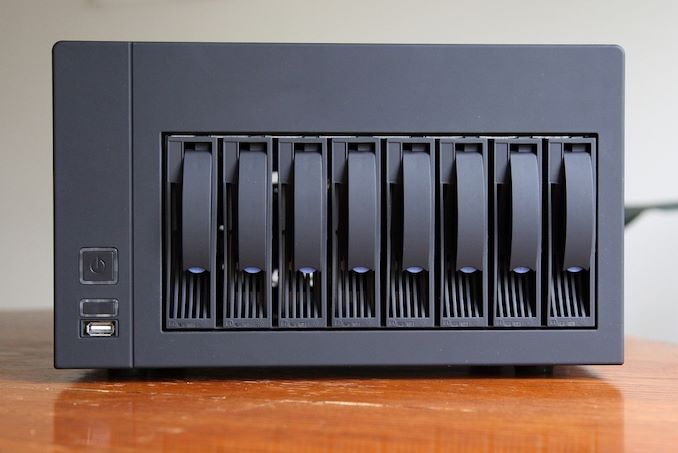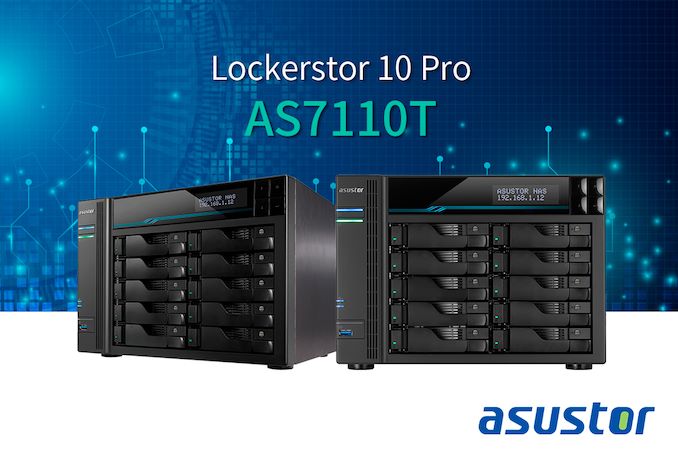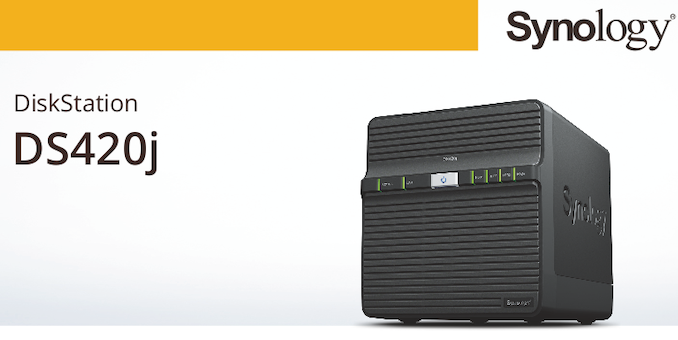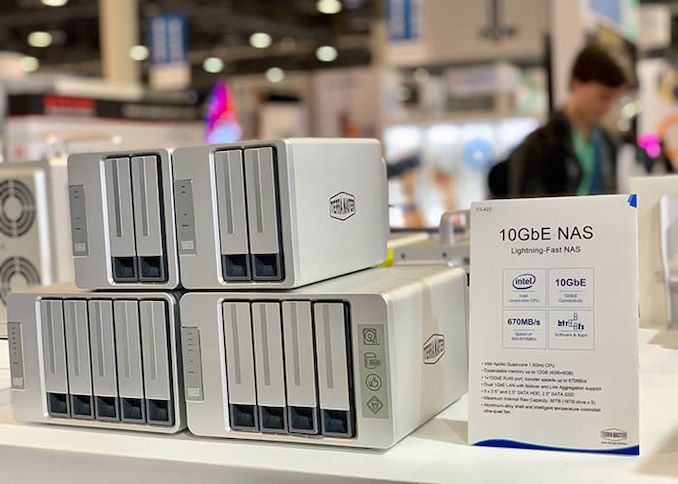Asustor, QNAP, and Synology Introduce New NAS Units at CES 2020
by Ganesh T S on January 10, 2020 6:00 PM EST- Posted in
- Storage
- NAS
- Synology
- QNAP
- Trade Shows
- Asustor
- TerraMaster
- CES 2020

The network-attached storage (NAS) vendors had a relatively quiet presence at CES 2020 compared to what we used to see in earlier years. We have a few announcements and show presence coverage from a couple of vendors to cover, but, a commentary on the current stage of the NAS market is first required to set the stage.
Where is the Network-Attached Storage Market Headed?
As an active follower of the network-attached storage (NAS) market and a media analyst covering CES for more than a decade, the change in the approach of the NAS vendors to the show over time has been interesting to observe. At a higher level, it also shows the direction in which the NAS market is headed. In the early 2010s, the cloud concept was still in its infancy and over-the-top (OTT) streaming was just taking off. However, the rise of smartphones and the associated user-generated content meant that consumers suddenly had a significant amount of data at home that needed access in a centralized manner. A number of vendors attempted to capitalize on this home consumer demand by releasing NAS units catering specifically to this market segment. Fast forward to 2020, and a number of things have changed on the home consumer front:
- Smartphones are backed up by virtually free and virtually unlimited cloud storage, and most consumers are not bothered by the downscaling of the photo and video resolutions
- Cloud-based services also enable easier sharing of content with contacts around the world - an aspect that has been a pain point when the content resides on a local NAS device.
- Cloud-based services such as OneDrive even provide ransomware protection - meaning that even PC / notebook backups for many consumers are moving to the cloud
- Physical media usage has dropped down considerably, and most consumers do not bother to back up their Blu-rays and DVDs. OTT services such as Netflix, Amazon Prime, Disney+, and Hulu are able to provide instant gratification with a good UI and steady stream of new content compared to media stored in a local server.
The factors mentioned above have led to the market for consumer-focused NAS devices experiencing little to no growth in the past couple of years. While the underlying data storage explosion thesis remains unchanged. However, the place where the data gets stored as well as the type of customers who want fast, reliable, and centralized storage with a focus on privacy have become skewed. From the perspective of NAS vendors, the primary growth area is in small businesses and enterprises. We will be seeing hardware and software features focusing on various segments of that market moving forward. For example, QNAP already has Thunderbolt 3-equipped NAS units for enterprises involved in media production.
Where does that leave the consumer NAS models? Since the area is not a growing segment, we will see second tier vendors such as ZyXEL (which last released new NAS units back in 2015) completely exit the market. We also believe that Netgear is completely dropping the home-consumer oriented models in the ReadyNAS lineup. Some vendors (such as Iomega / LenovoEMC) have lso completely exited the NAS market despite having had SMB- and enterprise-focused units in their lineup. Moving forward, the retail crowd will be served by units such as the Western Digital My Cloud Home / Home Duo / Expert / Pro series. Given the huge hard drive capacities, the retail crowd hardly needs more than four bays. This segment is also least bothered by aspects such as SSD caching. Synology, QNAP, and Asustor will release updated models of their 2-bay and 4-bay NAS units every year or two, but the main focus will be on their SMB offerings. On the software side, we believe that NAS apps such as Plex, Twonky Media Server etc. will slowly turn into abandonware. Prosumers and enthusiasts among the home consumers will end up purchasing low- and mid-range SMB NAS units for their privacy-focused centralized data storage needs.
The effects of the above trends has already been seen at CES over the last few years. In the early 2010s, Synology used to have a presence at one of the press events (Pepcom or ShowStoppers) and also a booth in the main show floor. QNAP used to have either a booth or a suite at one of the hotels. Asustor used to share a suite with Asus. At CES 2020, Synology had a fly-in and fly-out presence at Pepcom along with a 4-bay NAS announcement. QNAP did have a booth and a number of announcements, but the focus was mostly on business features. Asustor announced a new business NAS unit, but didn't have any presence at the show. Netgear didn't have any ReadyNAS units on display in their suite. We did have some upcoming / second-tier vendors such as Terramster displaying their wares at the show. Vendors such as QNAP, Synology, and Asustor have begun organizing their own annual user conferences to announce new products and software features. Additionally, other business conferences focused on virtualization, security etc. are turning out to be better events for these NAS vendors. Overall, CES is no longer an important show for the NAS market. Having said that, the rest of this piece captures some of the demonstrations and announcements made in the NAS space as part of CES 2020.
Asustor's Lockerstor 10 Pro
In H2 2019, Asustor had launched the Lockerstor 8 (AS6508T) and Locketstor 10 (AS6510T) tower form-factor NAS units along with demonstrations of the AS-T10G and AS-U2.5G 10Gb and 2.5Gb network adapters. They had also demonstrated updates to various native apps in the Asustor Data Manager (ADM) OS. These Denverton (Atom C3538) units came with dual Intel-based 10GBASE-T ports and dual Realtek-based 2.5G RJ-45 ports along with two M.2 NVMe SSD slots for caching purposes. Priced at $999 (AS6508T) and $1149 (AS6510T), they are cost-effective solutions for SMBs.
The Lockerstor 10 Pro (AS7110T) uses an Intel Xeon quad-core processor with DDR4 ECC memory. This 10-bay NAS comes with a 10Gb port as well as three 2.5Gb ports, has dual M.2 NVMe / SHCI SSD slots, and two USB 3.2 Gen 2 (10 Gbps) ports. Availability is slated for Q1 2020. We do not have any additional details as yet, but, it seems strange that the Lockerstor 8 and 10 come with dual 10Gb ports, while the Lockerstor 10 Pro has got to make do with just one. We have reached out to Asustor for further comments.
QNAP's TS-251D and TS-230
QNAP has been regularly releasing updates to their QTS and also announcing new hardware models throughout the year. As part of CES 2020, they announced the TS-251D (2-bay single-gigabit NAS featuring the Intel Celeron J4005, with a PCIe 2.0 x4 expansion slot for either additional M.2 SSDs or NBASE-T ports up to 10 Gb or USB 3.1 Gen 2 ports) and the TS-230 (2-bay single-gigabit NAS featuring a Realtek RTD1296 quad-core Cortex A53-based SoC and 2GB of DDR4 RAM) for home consumers.
QNAP also launched the VS-8348 VioStor NVR NAS with a Core i5-8400T and QVR Pro native app for SMB video surveillance recording needs. The company has also been focusing on AI solutions. As part of this, they are adding face recognition to their QVR Pro motion search functionality. The same technology is being demonstrated with the QVR Face to monitor staff attendance in office environments, and digital signage products. Another AI application is their KoiMeeter video conferencing solution that can provide audio transcription and real-time translation in meetings. The QuWAN QoS features helps optimize network bandwidth for unhindered meetings. The company has also been making a big push in the network infrastructure space with their Guardian switches. The QGD-1602P was the new product being demonstrated in this segment. An update to the existing QGD-1600P, it integrates 10G SFP+ ports and has a 370W total PoE budget. It can also run the QTS operating system. The QuCPE Edge Computing Server was also being displayed at CES 2020.
Synology's DS420j
Synology announced the 4-bay DS420j NAS at CES 2020, though the details of the unit have been public for a few months now. It is based on the same Realtek RTD1296 used by QNAP in its TS-230 unit. The DS420j accommodates two extra bays compared to that unit and comes with 1GB of RAM . There is a single gigabit LAN port and two USB 3.0 ports in the unit. The unit supports the ext4 filesystem only for the internal volume.
Synology is also promising new features in their updates to the Synology DSM over the course of 2020, but was silent on the details. We look forward to hearing about the new features shortly. On the business / enterprise side, Synology also announced the availability of the SA3600, a 12-bay Xeon-D 1567-based NAS with SATA / SAS support, two 10GB BASE-T ports, and four gigabit LAN ports. The 2U rackmount NAS also comes with two PCIe 3.0 x8 slots and can support both btrfs and ext4 for the internal volume. They key feature of the SA3600 is the expandability offered with the help of the 12- and 24-bay RX1217sas and RX2417sas expansion units. The maximum number of supported drive bays is 180.
Terramaster at CES 2020
Terramaster started off as a direct-attached storage (DAS) manufacturer. We had reviewed one of their offerings back in 2017. Recently, they have started a push on the NAS front too, with products targeting a wide range of customers ranging from home consumers to enterprises. The products on display at CES 2020 were actually the ones launched last year, but they did provide insight into the breadt of their offerings.
The key product from Terramaster, in our opinion, is the surprisingly affordable F5-422. At $570 for a 10GBASE-T Apollo Lake x86-based 5-bay unit supporting btrfs, it doesn't break the bank. However, the platform holds back the maximum speeds to around 650 MBps over the 10GBASE-T port. Terramaster's TOS 4.1 operating system is the Linux-based OS for their NAS units and it comes with a 'desktop-like' UI similar to Synology's DSM. The company also had rackmount enterprise NAS units based on Denverton and Core i3 platforms, as well as Thunderbolt 3-equipped DAS units at their booth.














63 Comments
View All Comments
Reflex - Sunday, January 12, 2020 - link
When I got rid of my server like that a few years ago and replaced it with my high end QNAP NAS, my power bill (plus noise in the house) went down enough to pay the price difference in about two years. Also much less management headache.HollyDOL - Saturday, January 11, 2020 - link
I've placed my bet on Helios64 yesterday, fingers crossed it proves to be a good choice.Valantar - Saturday, January 11, 2020 - link
The problem with the consumer NAS market is that they've done a very poor job marketing a product that has never reached commodity pricing, meaning that the only people buying them have been those already interested on their own and willing to pay for the privilege of not having a product pitched to them. When even Atom-based 4-bay units easily exceed $400 without drives anyone should be able to understand how the average user would rather pay for something simpler (online backup, external storage) or use a convenient free solution.I do all media storage on my HTPC, and will be spinning that out into a separate HTPC and DIY NAS for the next upgrade cycle. The price alone has been enough to make me dismiss any notion of buying a NAS. Sure, I'll need to learn how to set up FreeNAS or a similar OS, but I'll get a far more flexible, powerful and fully featured product for a far lower price. I completely understand that the vat majority of people are neither willing nor able to do this, but as a PC enthusiast already quite frankly I don't see this as much more of a commitment than buying an off-the-shelf NAS - and for the average user I can't imagine buying a NAS feels any less daunting than building one.
PaulHoule - Sunday, January 12, 2020 - link
The lesson of history is that people don't learn from history.In the 1990s, Intel crushed the competition in medium-to-high performance processors. In terms of price-performance nobody could compete so companies that made RISC workstations such as Sun, SGI and IBM were pushed out of the market.
Circa 2000 NAS and router devices tried to save money on chips by using MIPS and other low-performance and even lower performance-price ratio products. I saw so many devices that struggled to serve files over SMB in that time frame, took forever to boot, etc. You might save 10% on the BoM using that kind of chip, but then take a 10x cut in performance, and then the vendor would feel like they have to shortchange you on memory.
Circa 2010 Intel decided it wanted to dominate the market for "low performance but expensive for what you get" just around the time that medium-performance ARM chips became a commodity product that was well priced. Companies like Samsung still work overtime to put junk chips in devices like the SmartThings hub, but "penny wise and pound foolish" is the definition of the modern enterprise.
I got a cheap tower server that was built locally, with a real i5 processor. I know enough not to mess around with Atom or Celeron, you won't really save money but you will get a huge performance loss that just isn't it worth it. (Now American car companies would make bad small cars and change the name every few years... Why doesn't Intel do that? At that point they might fool somebody twice instead of once.)
The specs of my machine are on an entire different level. I think in 2020 a Linux machine with just 1G of RAM is going to struggle to boot, never mind serve files. My server has 32GB, and it has a lot of USB 3 ports that I can use to move content on and off removable drives, mobile devices, etc. My machine has a 1050GTX graphics card so it can transcode video without working a sweat.
What people just don't get today is that people DO NOT experience the mean or median performance, what makes your computer painful to use is the 95-99% percent slowdowns and the answer to that, if you value your time, your frustration, your attention, your blood pressure, etc. is that you need to have more power than strictly necessary. If you try to lowball the specs and do it with non-commodity pricing you are getting the worst of both worlds.
haukionkannel - Sunday, January 12, 2020 - link
It seem that I have to wait Many year more... an affordable 10Gb 4 to 5 storage nas with One or two slot m2 ssd cache.Most options Are enterprice level devices with more space than I ever need or slow 1Gb or 2.5gb lan speeds...
MadAd - Sunday, January 12, 2020 - link
> an affordable 10Gb 4 to 5 storage nas with One or two slot m2 ssd cache.For me this is the ideal baseline 4 bay prosumer unit going forward too, but im sure the NAS vendors know this. Dont forget to add on the time lag waiting for a residential 10gbe switch, the home market is still waiting on an affordable consumer unit, and then motherboards need to start offering 5 or 10gbe as standard then we can truly wave bye to 1gbe.
haukionkannel - Monday, January 13, 2020 - link
I have allready 10gb motherboard, and 10gb swich are now from $150 to $450 for my needs...Only nas are not there yet, unles i buy 12 bay enterprice nas... I have a lot of files, but no so much and not ready pay $1500+ for that huge box.
Foeketijn - Sunday, January 12, 2020 - link
No Design wins for AMD then. No Ryzen R1000 or Epyc 3000. Everybody forgot the reliability issues with embedded Apollo Lake processors?evilpaul666 - Sunday, January 12, 2020 - link
Any suggestions for good enclosures to roll your own? 4 drive bays and room for a 280mm radiator would be ideal.rkhalloran - Monday, January 13, 2020 - link
I have a two-bay Intel-based Synology NAS which replaced one of their earlier ARM units and has worked well as a media tank. That said, I note that the Twonky Media Server I use there for DLNA has apparently gone under per the Wikipedia article: "Twonky Server was maintained all the time by the former TwonkyVision employees which worked for the German subsidiary Lynx Germany GmbH. Lynx Germany GmbH was shut down 10/2018". I'm unsure if the US division is maintaining it...